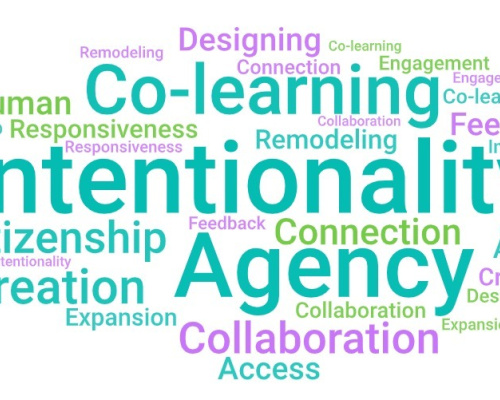Digital Pedagogy: What It Can Mean and Do
Date
Technology offers opportunities to think intentionally about what teaching and learning can be. Engaging in critical digital pedagogy takes educators way past “substituting” with technology.
The Art of Digital Pedagogy
Educators frequently practice at the intersection of knowledge and inquiry. They make decisions both planned and off-the-cuff about when, how, and why to use any tool or method, whether digital or not, to support their students’ learning. Digital pedagogy, as a subset of pedagogy, asks educators to employ a lens of criticality while making intentional decisions about using technology to support teaching and learning.
As the scholarly journal Hybrid Pedagogy reminds us, digital pedagogy is not just about “using digital technologies for teaching.” Rather, it’s about “approaching those tools from a critical pedagogical perspective,” so enacting one’s digital pedagogy can even drive decisions “not to use digital tools” [emphasis added].
In “Listening for Student Voices,” the authors apply a constructivist angle to digital pedagogy, asserting that for students, “critical and independent thinking are the most valuable products of learning.” They encourage educators to make space for students to work and create on their own, asking students to invent products that demonstrate “their own learning” as well as products demonstrating knowledge. This emphasis on critical and independent thinking connects digital pedagogy to the ideas of constructivism that:
- Students learn best when actively engaged (not when passively receiving);
- Learning is a social process; and,
- The goal of teaching and learning is to provide students with a range of experiences that facilitate their connections and construction of knowledge.
It’s the process of envisioning why and how to implement technology that can make digital pedagogy challenging.
Three Ideas About What Digital Pedagogy Can Be
The scholarship on digital pedagogy and even the term “digital pedagogy” and its use continue to evolve. We at Clarity Innovations think of digital pedagogy as generally organized around three major ideas: intentionality, co-learning and agency, and transformative teaching.
Intentionality.
Frameworks like TPACK illustrate the essential relationships between content, pedagogy, and technology. TPACK supports educators and builds their confidence in making intentional pedagogical decisions about integrating tools and technologies into learning experiences. Educators use the scaffolding the TPACK framework offers to think deeply about their intentionality when creating learning experiences. They consider the content—including concepts and skills—and the methods they and students can use to meet content objectives. Educators decide which technology can both illuminate the content and support the pedagogy by considering three important questions:
- What will students learn or what knowledge might they construct?
- What method(s) will support students in meeting the objectives?
- What tools and resources do students need to be successful?
Intentionally considering the use of technology may require some educators to view knowledge as dynamic and re-envision their roles as interactive and responsive, rather than directive.
When educators engage in this thinking to reflect on, create, and design learning experiences, they can pay specific attention to the intentionality behind their pedagogical decisions and find opportunities for students to lead their own learning.
Co-learning and agency.
Universal Design for Learning (UDL) serves as a helpful foundation for exploring and applying digital pedagogy. UDL emphasizes conditions for students to do “expert learning” in which students learn how to learn, set goals, and share what they know. The UDL framework also helps educators develop in their roles as co-learners, positioned alongside and among their students instead of “standing and delivering.” It provides ideas for educators on how to give students agency in choosing how to learn and share knowledge.
In “What is Digital Pedagogy?”, Sean Michael Morris asserts, “We cannot compensate for all the ways that students will choose to process and curate their learning in digital spaces, and so it becomes vital to teach students not about particular tools, but about how to choose tools for their use.”
“...it becomes vital to teach students not about particular tools, but about how to choose tools for their use.”
This suggests that when practicing digital pedagogy, educators must offer students learning experiences that feature multiple means of engagement, representation, action, and expression, whether or not these means employ digital tools or materials.
Transformative teaching.
Developing their digital pedagogy provides an opportunity for educators to (re)consider how they manage and organize their instruction, including how and when students connect with their learning processes, build on prior understanding, and apply or share what’s going on in the classroom with others in their community.
Intentionally integrating tools and technology gives educators opportunities to increase student dialogue, discourse, and reflection, and to bypass the walls of their classrooms (or wherever students are engaged in studying the world around them) so that learning can happen anywhere, anytime, and in any model.
Championing What Works in Digital Pedagogy
We apply frameworks like TPACK and UDL so our clients’ end user educators can bring transformative practices into their daily teaching routines, and so learners of all ages can engage with new ideas and develop new skills through authentic experiences. As educators and professionals working at the intersection of technology and instruction, we feel a responsibility to promote and apply research- and evidence-based practices that offer meaningful integration in the many, many “real worlds” that exist in schools today. When we partner with clients to create their solutions, we’re seeking to take their education communities beyond delivering on content-specific knowledge or “substituting” with technology to apply instead what really works in digital pedagogy, and what makes digital pedagogy really work.

